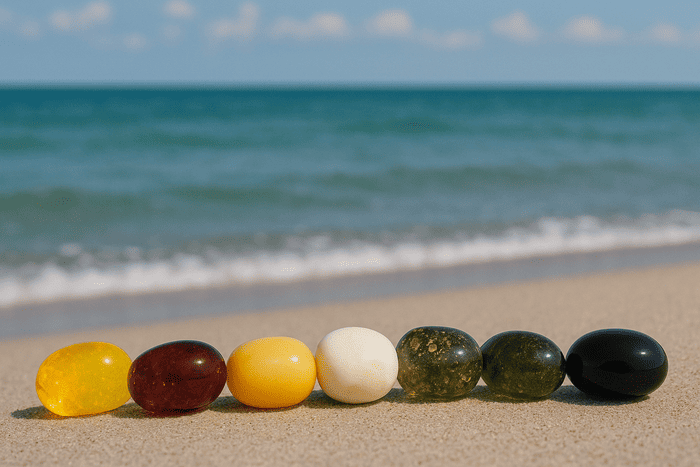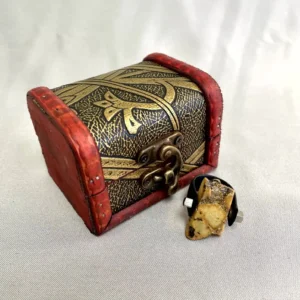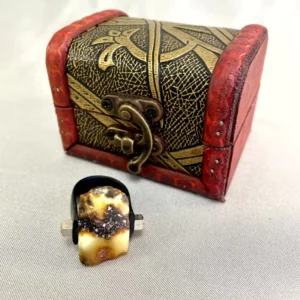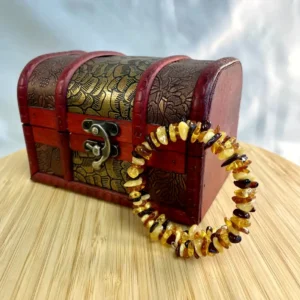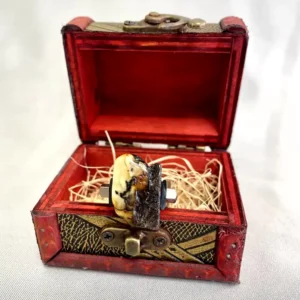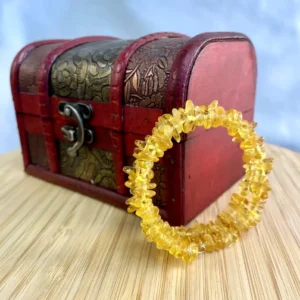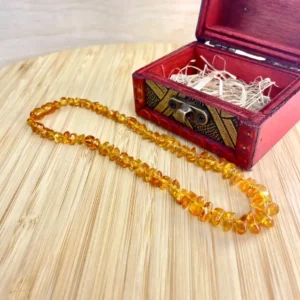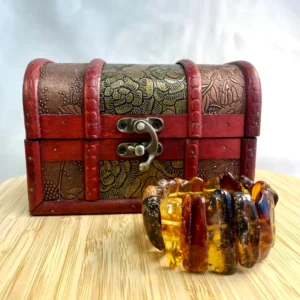For thousands of years, Baltic amber has been cherished not only for its beauty but for its extraordinary diversity of color and the fascinating inclusions it holds within.
Each piece is a time capsule of prehistoric life — a golden fossil of light, resin, and memory.
Yet few realize that Baltic amber spans an astonishing color spectrum: from sunny yellows and rich cognacs to rare greens, reds, and even milky whites.
Every shade tells a story — of trees and forests, oxidation, and the patient artistry of time.
In this guide, we’ll explore:
- The full range of Baltic amber colors (from common to extremely rare)
- How these colors form naturally over millions of years
- The origins and regions that shape Baltic amber’s beauty
- The mesmerizing world of amber inclusions — ancient insects, plants, and air bubbles preserved for eternity
Let’s step into the ancient light of the Baltic and uncover the secrets hidden within its colors.
The Origins of Baltic Amber: Where Time Turned Resin into Gemstone
Before diving into color, it’s essential to understand how Baltic amber came to be—and why it’s unlike any other amber in the world.
Formation of Baltic Amber
Around 44–50 million years ago, vast forests covered northern Europe. Trees of the Pinus succinifera species released resin to heal bark and protect against insects. Over time, rivers carried the resin to the seabed, where it fossilized under layers of sediment, transforming into amber.
The result was Baltic amber, the world’s oldest and most stable form, rich in succinic acid (up to 8%)—a compound found only in amber from the Baltic region. This unique chemistry influences its color variety, transparency, and even scent.
The Baltic Region: Source of the World’s Finest Amber
The term “Baltic amber” refers to amber found along the Baltic Sea coast, primarily in:
- Lithuania (especially near Palanga and Nida)
- Latvia
- Poland (Gdańsk and Kaliningrad area)
- Russia (Kaliningrad region)
Each coastline yields amber with distinct hues and inclusions, shaped by millions of years of geological and environmental influence.
Baltic amber accounts for over 90% of the world’s amber supply, making it the benchmark for quality, durability, and beauty.
The Full Spectrum of Baltic Amber Colors
Unlike gemstones that gain color from mineral impurities, Baltic amber’s colors result from oxidation, air bubbles, and the aging of resin compounds. Over millions of years, these natural processes produced more than 250 known color variations, though most fall into several main categories.
Let’s explore each one – from the most common to the rarest.
Honey Amber (Golden Yellow)
Honey amber is the most iconic and widely recognized color—what most people picture when they think of amber.
- Color range: From pale yellow to deep golden-orange.
- Transparency: Semi-transparent to translucent.
- Formation: Created by gradual oxidation of resin exposed to air pockets.
- Symbolism: Warmth, energy, and the sun’s vitality.
Honey amber dominates Baltic amber necklaces and amber bracelets because of its glowing radiance and universal appeal.
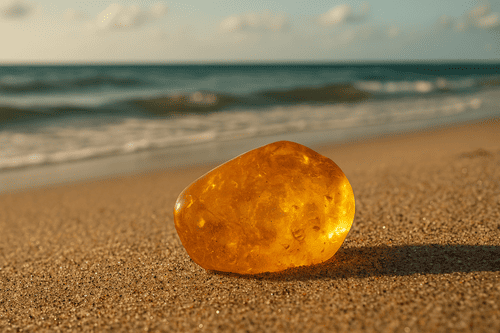
Cognac Amber
Named for its resemblance to aged brandy, cognac amber is one of the most luxurious and popular tones in Baltic amber jewelry.
- Color range: Deep golden brown to reddish-gold.
- Transparency: High—light passes through beautifully.
- Formation: From aged resin rich in organic compounds that darken with oxidation.
- Symbolism: Strength, maturity, sophistication.
Cognac amber looks especially striking in men’s amber rings and bracelets, offering an elegant, masculine warmth.
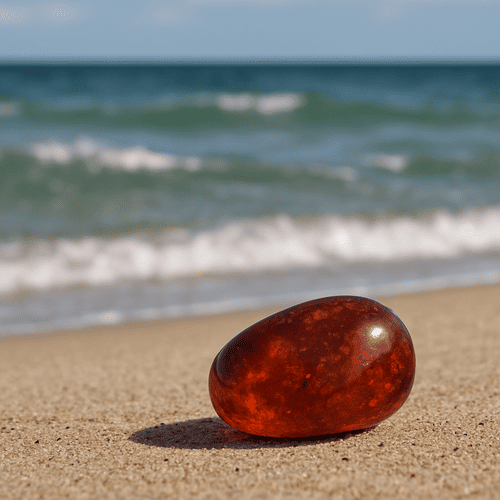
Yellow Amber
Distinct from honey amber, yellow amber is brighter and often more opaque.
- Color range: Lemon-yellow to sunny gold.
- Transparency: Semi-opaque with scattered internal bubbles.
- Formation: Due to tiny air inclusions and surface oxidation.
- Symbolism: Joy, optimism, intellect.
Yellow amber’s cheerful tone makes it a favorite for vintage-style Baltic amber necklaces and beads.
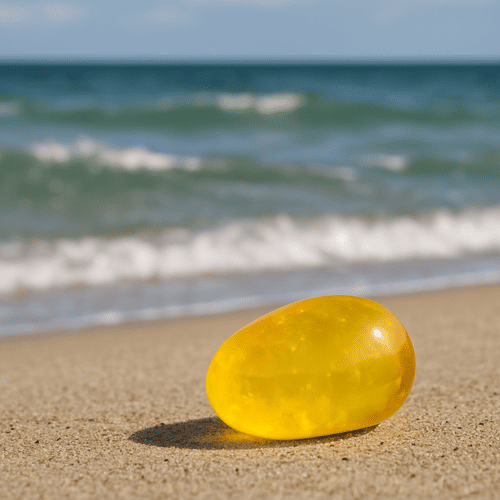
Butterscotch Amber (Royal Amber)
Butterscotch amber, also known as royal amber, is one of the most coveted Baltic amber colors.
- Color range: Creamy ivory, butter-yellow, to pale orange.
- Transparency: Opaque or milky.
- Formation: Caused by millions of microscopic air bubbles trapped during fossilization—about 10,000 per square millimeter.
- Symbolism: Nobility, peace, and timelessness.
In the past, royal amber was prized by European aristocracy and often used in royal jewelry. Today, it remains a collector’s favorite, especially in amber rings and pendants.
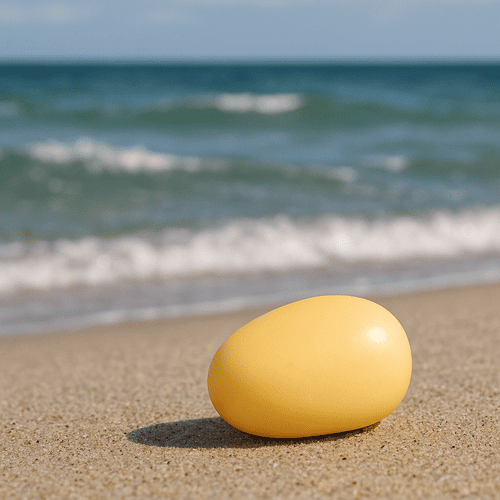
White Amber (Bone Amber)
Rarer still is white Baltic amber, sometimes called bone amber because of its cloudy, ivory appearance.
- Color range: Snow-white to pale cream, sometimes with marbled veins.
- Transparency: Fully opaque.
- Formation: Air bubble concentration up to 200,000 per square millimeter.
- Rarity: Less than 2% of all Baltic amber.
- Symbolism: Purity, wisdom, and serenity.
White amber’s soft matte glow makes it distinctive, often paired with silver to enhance its purity.
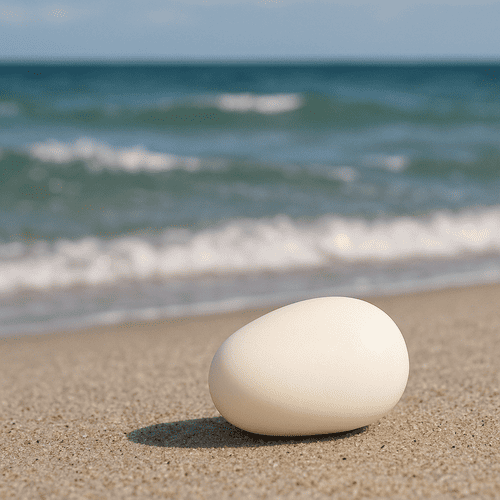
Green Amber
Although less common, green Baltic amber is highly prized for its depth and exotic hue.
- Color range: Olive, mossy, or forest green.
- Transparency: Varies from translucent to dark opaque.
- Formation: Created when organic debris, plant matter, or soil minerals interact with the resin during fossilization.
- Symbolism: Growth, balance, and connection with nature.
Natural green amber is rare (around 2% of finds). Some jewelry is heat-treated to enhance the green tone, though true natural green amber from the Baltic remains extremely valuable.
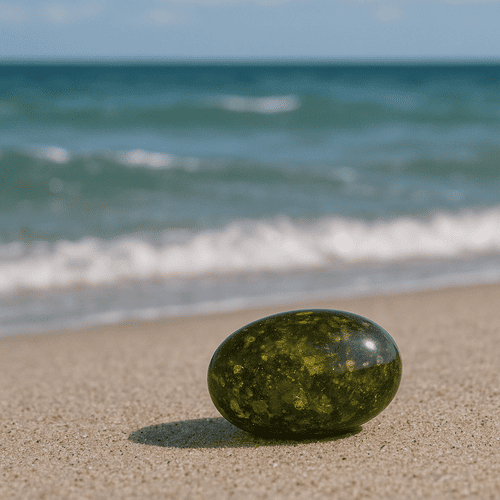
Red Amber (Cherry Amber)
Red or cherry amber is one of the rarest and most visually striking Baltic amber colors.
- Color range: Burgundy, dark orange-red, or deep wine.
- Formation: Created by oxidation over millions of years, or by natural heat and sunlight darkening the surface layer of amber.
- Transparency: Usually transparent or translucent.
- Rarity: Approximately 0.5–1% of all Baltic amber.
- Symbolism: Passion, vitality, courage.
True red amber glows with fiery brilliance and is often used in statement amber rings and bracelets.
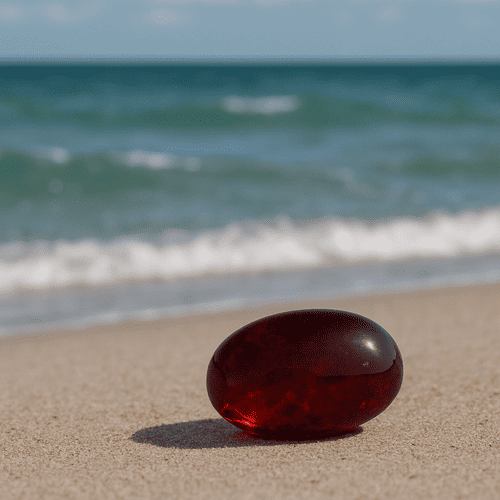
Black Amber
Despite its name, black amber isn’t truly black—it’s usually a very dark brown with hints of red or green visible under strong light.
- Formation: From resin mixed with soil, bark, or other organic materials during fossilization.
- Transparency: Opaque.
- Rarity: Around 15% of amber found along the Baltic coast.
- Symbolism: Grounding, protection, and depth.
Black amber pairs beautifully with polished metals, giving Baltic amber jewelry a bold and earthy presence.
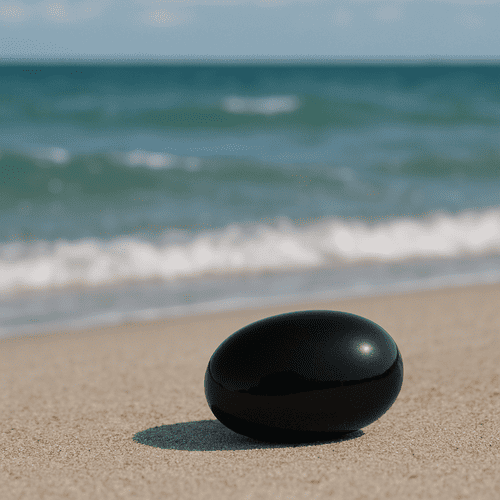
How Baltic Amber Colors Form Naturally
The diversity of Baltic amber colors is a masterpiece of nature’s chemistry and time. Several factors influence color and opacity:
- Oxidation: As resin interacts with oxygen and sunlight over millions of years, it darkens—from light yellow to deep cognac and red.
- Inclusions: Air bubbles and organic material scatter light, creating opaque tones like white and butterscotch.
- Pressure & Temperature: Variations in burial depth and heat affect density and hue.
- Mineral contact: Amber that fossilized near clay or soil layers often gained green or darker tones.
- Aging: Over millennia, transparent amber can slowly deepen in color as resins polymerize further.
Thus, every hue tells a story—of forest life, atmosphere, and time itself.
The World of Inclusions: Life Trapped in Time
One of Baltic amber’s most extraordinary features is its inclusions—tiny remnants of prehistoric ecosystems preserved within.
Amber inclusions are more than curiosities; they are invaluable scientific fossils, offering a direct window into the Eocene epoch (44 million years ago).
Common Types of Inclusions Found in Baltic Amber
- Insects – The most famous inclusions. Flies, mosquitoes, beetles, ants, spiders, and even small wasps or termites have been found perfectly preserved.
- Plant material – Needles, leaves, flowers, moss, and even fragments of ancient pine bark.
- Air bubbles – Contain ancient atmospheric air—literally a snapshot of prehistoric climate conditions.
- Mineral dust or pollen – Fine particles reveal the composition of ancient forests.
These inclusions make each piece of Baltic amber jewelry a miniature world—a relic of long-lost life.
Rare and Extraordinary Inclusions
While most inclusions are insects or plants, a few discoveries have stunned scientists and collectors alike.
Rarest inclusions ever found in Baltic amber include:
- Small vertebrates – Lizards, frogs, and even fragments of bird feathers.
- Mites and ticks on dinosaur feathers – Providing proof of parasitic behavior in ancient species.
- Bubbles with liquid water – Containing droplets sealed for tens of millions of years.
- Spiders capturing prey – Scenes of life frozen mid-action.
One of the rarest inclusions ever found was a small snail shell with preserved soft tissue, discovered in Baltic amber and estimated at 40–45 million years old—a discovery that reshaped our understanding of ancient ecosystems.
Such pieces are museum-grade rarities, often worth tens of thousands of dollars.
Symbolic Meaning of Amber Inclusions
In jewelry, inclusions are often viewed not as imperfections but as stories—symbols of preservation, transformation, and eternal memory.
- Insects represent endurance and connection to nature.
- Plants symbolize growth and healing.
- Air bubbles embody purity and the breath of life.
When worn, amber with inclusions carries both historical significance and emotional resonance—each a preserved heartbeat of Earth’s history.
How Collectors and Jewelers Value Baltic Amber Colors and Inclusions
The value of Baltic amber jewelry depends on three main factors: color, clarity, and inclusion type.
| Attribute | Common | Rare | Exceptional |
|---|---|---|---|
| Color | Honey, yellow | Butterscotch, white, green | Cherry red, rare mixed tones |
| Clarity | Opaque or cloudy | Semi-transparent | Transparent with inclusions |
| Inclusions | None or air bubbles | Small insects | Vertebrates or rare flora |
Highest value combinations:
- Deep cherry amber with perfect clarity.
- Opaque white or butterscotch amber in large polished pieces.
- Transparent amber with rare inclusions, especially recognizable insects or plants.
Collectors often pair colors and inclusions for contrast—e.g., a honey amber necklace interspersed with white amber beads, or a cognac amber ring showcasing a visible inclusion.
Why Understanding Baltic Amber Colors & Inclusions Matters
For collectors, artisans, and admirers alike, knowing about Baltic amber colors and inclusions deepens appreciation for this organic gem.
- It helps identify genuine Baltic amber versus non-Baltic varieties.
- It reveals the natural processes shaping each shade.
- It transforms amber from a simple accessory into a piece of prehistory you can wear.
Every amber necklace, bracelet, or ring carries the light of an ancient forest—and possibly, a tiny life form that once lived beneath its trees.
Frequently Asked Questions About Baltic Amber Colors, Origins & Inclusions
Q1: How many colors does Baltic amber come in?
Over 250 natural shades have been identified, though the main Baltic amber colors are honey, cognac, yellow, white, butterscotch, green, red, and black.
Q2: What causes the different colors of Baltic amber?
Colors form due to oxidation, trapped air bubbles, minerals, and varying degrees of pressure and heat over millions of years.
Q3: Which Baltic amber color is the rarest?
Natural cherry red and white (bone) ambers are among the rarest, with green and butterscotch also considered highly valuable.
Q4: Does Baltic amber ever appear blue?
No. Blue amber is found in the Dominican Republic, not in the Baltic region. Baltic amber may show subtle iridescent reflections, but it’s not truly blue.
Q5: What are amber inclusions?
Inclusions are prehistoric insects, plants, or air bubbles trapped in the resin before it hardened. They make amber scientifically and aesthetically unique.
Q6: What is the rarest inclusion ever found in Baltic amber?
Small vertebrates—such as lizards or bird feathers—are the rarest. Some pieces even contain entire scenes of predator-prey interaction frozen in time.
Q7: How do inclusions affect the value of amber?
Well-preserved and identifiable inclusions greatly increase value, especially when the amber is clear and the inclusion is visible from multiple angles.
Final Thoughts: The Living Light of the Baltic
The beauty of Baltic amber lies not in perfection, but in diversity. Every hue, from honey to ivory to cherry, captures a different facet of time itself.
Each inclusion, whether an insect or a wisp of air, is a whisper from an ancient world—life, once living, now immortalized in golden resin.
To hold Baltic amber is to hold history, color, and light—all in one timeless gemstone. Whether crafted into amber necklaces, bracelets, or rings, each piece is more than jewelry—it’s a story millions of years in the making.
Baltic amber is, and will always be, the light of the North—a masterpiece painted by nature’s oldest hand.
